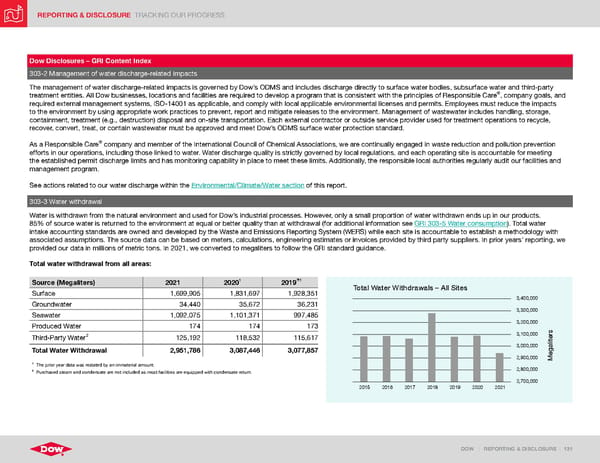REPORTING & DISCLOSURE TRACKING OUR PROGRESS DOW | REPORTING & DISCLOSURE | 131 Dow Disclosures – GRI Content Index 303-2 Management of water discharge-related impacts The management of water discharge-related impacts is governed by Dow’s ODMS and includes discharge directly to surface water bodies, subsurface water and third-party treatment entities. All Dow businesses, locations and facilities are required to develop a program that is consistent with the principles of Responsible Care ® , company goals, and required external management systems, ISO-14001 as applicable, and comply with local applicable environmental licenses and permits. Employees must reduce the impacts to the environment by using appropriate work practices to prevent, report and mitigate releases to the environment. Management of wastewater includes handling, storage, containment, treatment (e.g., destruction) disposal and on-site transportation. Each external contractor or outside service provider used for treatment operations to recycle, recover, convert, treat, or contain wastewater must be approved and meet Dow’s ODMS surface water protection standard. As a Responsible Care ® company and member of the International Council of Chemical Associations, we are continually engaged in waste reduction and pollution prevention efforts in our operations, including those linked to water. Water discharge quality is strictly governed by local regulations, and each operating site is accountable for meeting the established permit discharge limits and has monitoring capability in place to meet these limits. Additionally, the responsible local authorities regularly audit our facilities and management program. See actions related to our water discharge within the Environmental/Climate/Water section of this report. 303-3 Water withdrawal Water is withdrawn from the natural environment and used for Dow’s industrial processes. However, only a small proportion of water withdrawn ends up in our products. 85% of source water is returned to the environment at equal or better quality than at withdrawal (for additional information see GRI 303-5 Water consumption ). Total water intake accounting standards are owned and developed by the Waste and Emissions Reporting System (WERS) while each site is accountable to establish a methodology with associated assumptions. The source data can be based on meters, calculations, engineering estimates or invoices provided by third party suppliers. In prior years’ reporting, we provided our data in millions of metric tons. In 2021, we converted to megaliters to follow the GRI standard guidance. Total water withdrawal from all areas: Source (Megaliters) 2021 2020 1 2019 1 2,700,000 2,800,000 2,900,000 3,000,000 3,100,000 3,200,000 3,300,000 3,400,000 2021 2020 2019 2018 2017 2016 2015 Megaliters Total Water Withdrawals – All Sites Surface 1,699,905 1,831,697 1,928,351 Groundwater 34,440 35,672 36,231 Seawater 1,092,075 1,101,371 997,485 Produced Water 174 174 173 Third-Party Water 2 125,192 118,532 115,617 Total Water Withdrawal 2,951,786 3,087,446 3,077,857 1 The prior year data was restated by an immaterial amount. 2 Purchased steam and condensate are not included as most facilities are equipped with condensate return.
 ESG Report | Dow Page 130 Page 132
ESG Report | Dow Page 130 Page 132